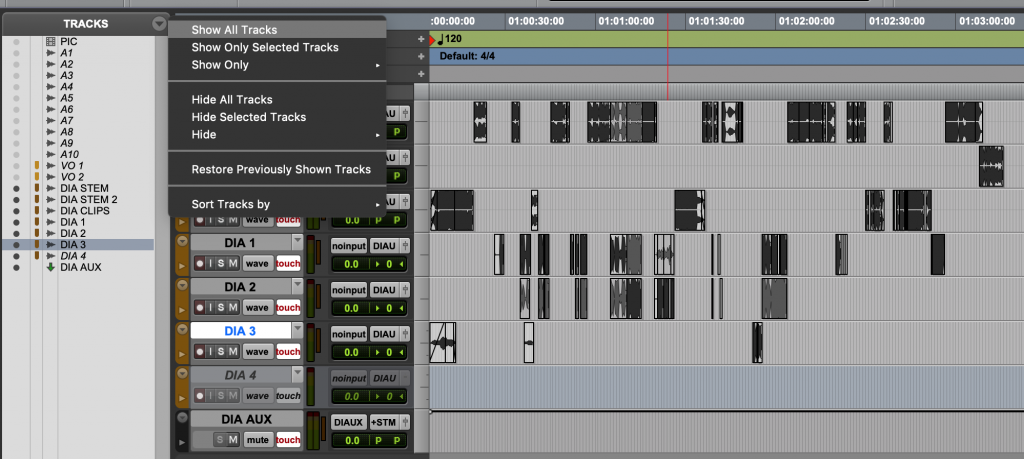If you are delivering an audio edit to a mixer, the process is fairly simple.
- Save session as a new file name (for your own reference, so using the same naming convention with “delivery” at the end)
- Delete Unnecessary Tracks
- Do a Save Session Copy
- Get copy to the mixer
The goal of this process is to remove all the “stuff” they don’t need. Your session won’t necessarily be playable at the end, but it will be cleaner/easier for the mixer to work with.
Save session name
For example, if your project is called PROJECT DIA EDIT 03, you could name it PROJECT DIA EDIT DELIVERY.
Delete Unnecessary Tracks
If you have any work tracks, template tracks, or anything unnecessary to the mixer, delete it. Start by showing all tracks:

Then, delete anything unnecessary. In this case, we are going to delete the original AAF tracks and video track.

Here’s the after:

Then, switch to mix view and remove all plugins. If you hold down “option” on Mac while selecting “no insert” it will delete the plugins on every track for that same insert (ie, all the compressors will go away by removing one of them and holding Option). Don’t forget to check Inserts F-J, in case you use them.

Some people go as far as removing all the inputs/outputs

And unnecessary I/O. It’s not crucial to do this, but it does tidy things up. Ideally a mixer won’t be pulling all your IO but occasionally it happens by accident.

Save Session Copy
This is the session that will be going to your mixer so it’s important to name this appropriately. It should be named so anyone could look at it and know what it is without having to ask you questions or have any doubts about it. There may be times where you deliver something to a mixer who’s working in a different time zone or who just works totally off hours from you. The last thing you need is a mixer calling you while they’re burning time on the clock trying to figure out what’s going on with your edit sessions.
The session name should include:
- The name of the project
- Reel or act numbers (if what you’re delivering isn’t complete)
- Your initials or name (if there are more than one editor)
- The word “Delivery” (so it’s clear it’s a session being delivered to someone else)
Here’s some examples of good session names for the project APP:
- APP DIALOG EDIT DELIVERY
- APP Dialog Edit Delivery 1-20-20 Joe Smith
- APP Dialog Edit Delivery Reel 1 JS
Get Copy to the Mixer
If you’re working digitally, there’s a couple steps to getting the files to a mixer. First, compress/zip the session so you are only sending one file. If there’s even one missing or corrupt file, you’ll have to redo the whole thing – and the mixer might be on the clock and waiting. It’s best to just zip it up front – and even check the zip to make sure it uncompresses properly. That way, it speeds up the work you need to do troubleshooting if there is a problem and the clock is ticking.
What service you use to send files to the mixer: this is a discussion to have with the mixer early on (like, not the night before delivering, ideally). They may have an FTP or service they prefer because it will be faster for them to download on their end. If you’re responsible for doing it on your own, Dropbox, Box, and Google Drive all have free account options that should generally have enough space to get sessions over.
Conclusion
Now that you know the basics of dialog editing: all these rules will probably be broken at some point. It’s possible you’ll work for a mixer who wants to do something very different from what we covered here. As we said before, dialog editors have to be chameleons who can change their editing style for whoever is receiving the edit.
The material you get from project to project will be different every time and there will be a new challenge to every project. This is why we’re not covering every possible scenario or problem because you will learn a lot through this exploration.
In general, use your ears – if something doesn’t seem to be working, try doing something that sounds better. More often than not, the best solution is the one that sounds ok to you.
Other articles from Pro Audio Girl
- How do you find work as a dialog editor?
- 5 Tips To Land A Job At A Post-Production Sound Studio
- Post-Production Basics: Mixing With Broadcast Limiters And Loudness Meters
- Post-Production Basics: Sound Editing – Dialog
Products that may be useful
- Pace iLok 3.0
- Waves Diamond Plug In Bundle (Native)
- Audio-Technica ATH-M50x Professional Studio Monitor Headphones, Black
- SONARWORKS Reference 4 Studio Edition Speaker, Monitor, and Headphone Calibration Software with Measurement Microphone
Dialog Editing Course
- Part 1: Why Learn Dialog Editing?
- Part 2: The Elements of Dialog and Voiceover
- Part 3: The Challenges of Dialog Editing & Mixing
- Part 4: Stems and Specs for Dialog Editors
- Part 5: Prepping for Dialog Editing
- Part 6: Dialog Editing Basics
- Part 7: Dialog Organization for Different Projects
- Part 8: Other Responsibilities for the Dialog Editor
- Part 9: Frankenbites
Dialogue Editing is really enjoyable and rewarding, and I’m trying to make a career out of it.
I love how you’ve codified so much here!
Sincerely, THANK YOU.